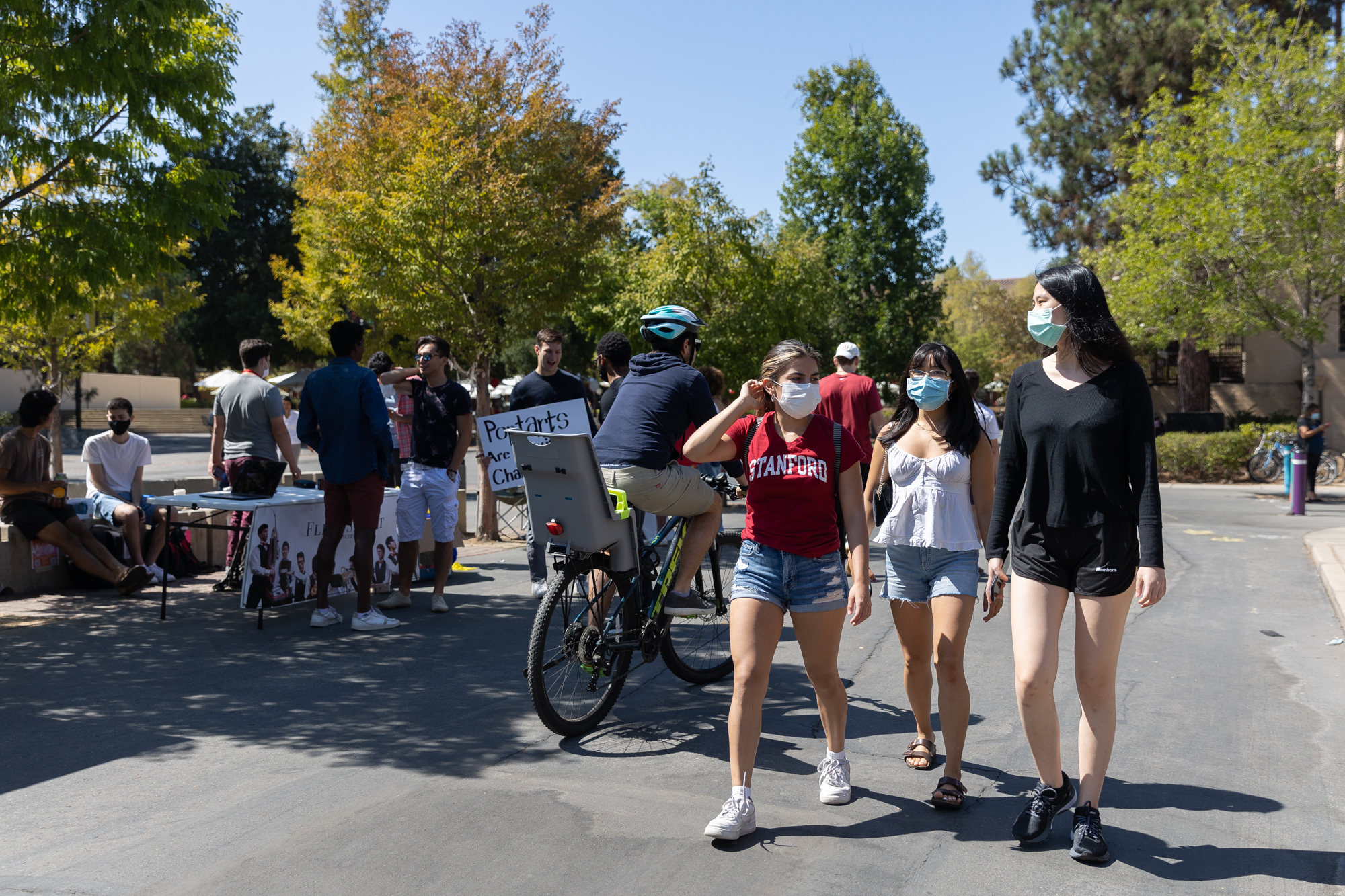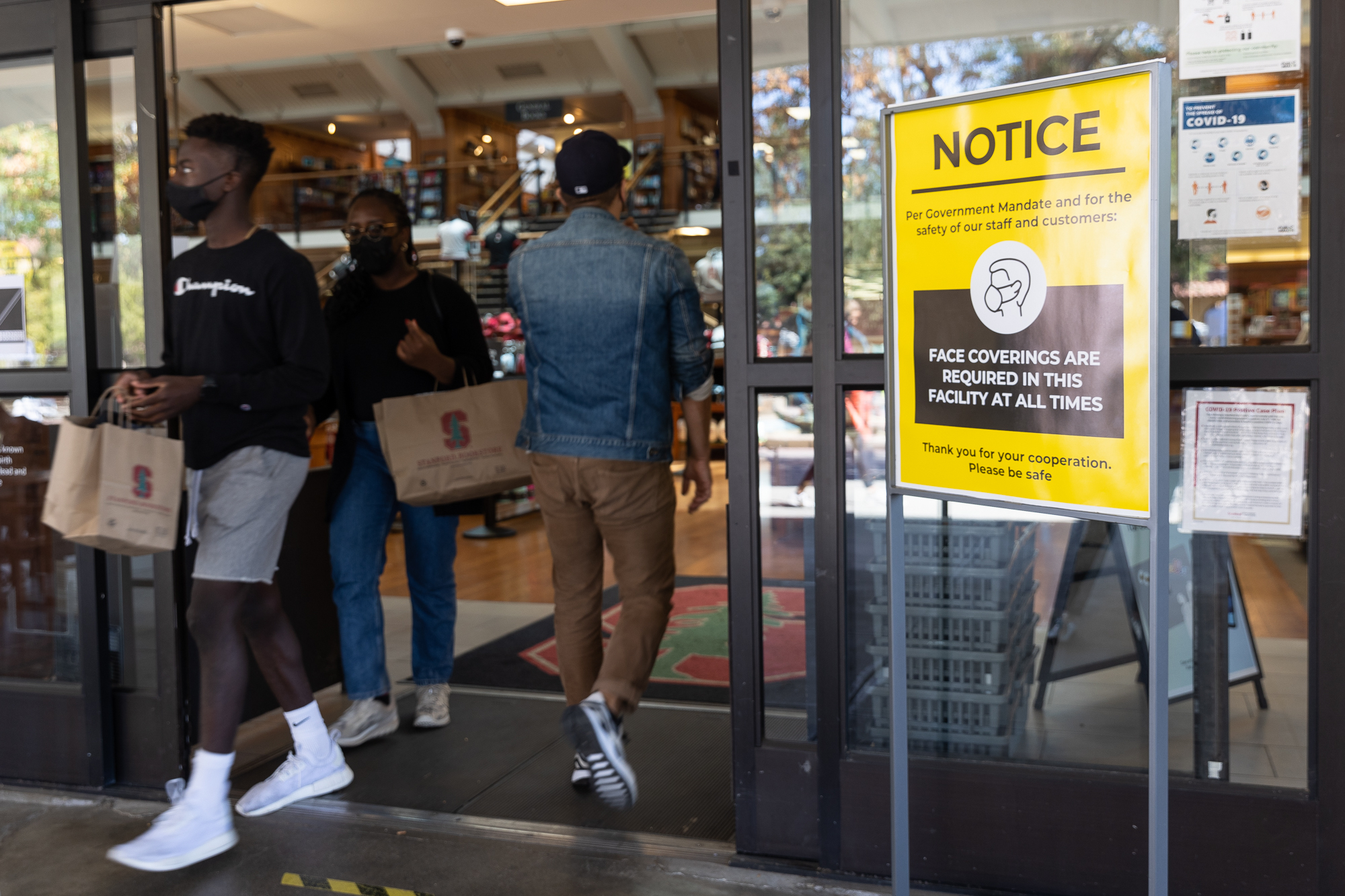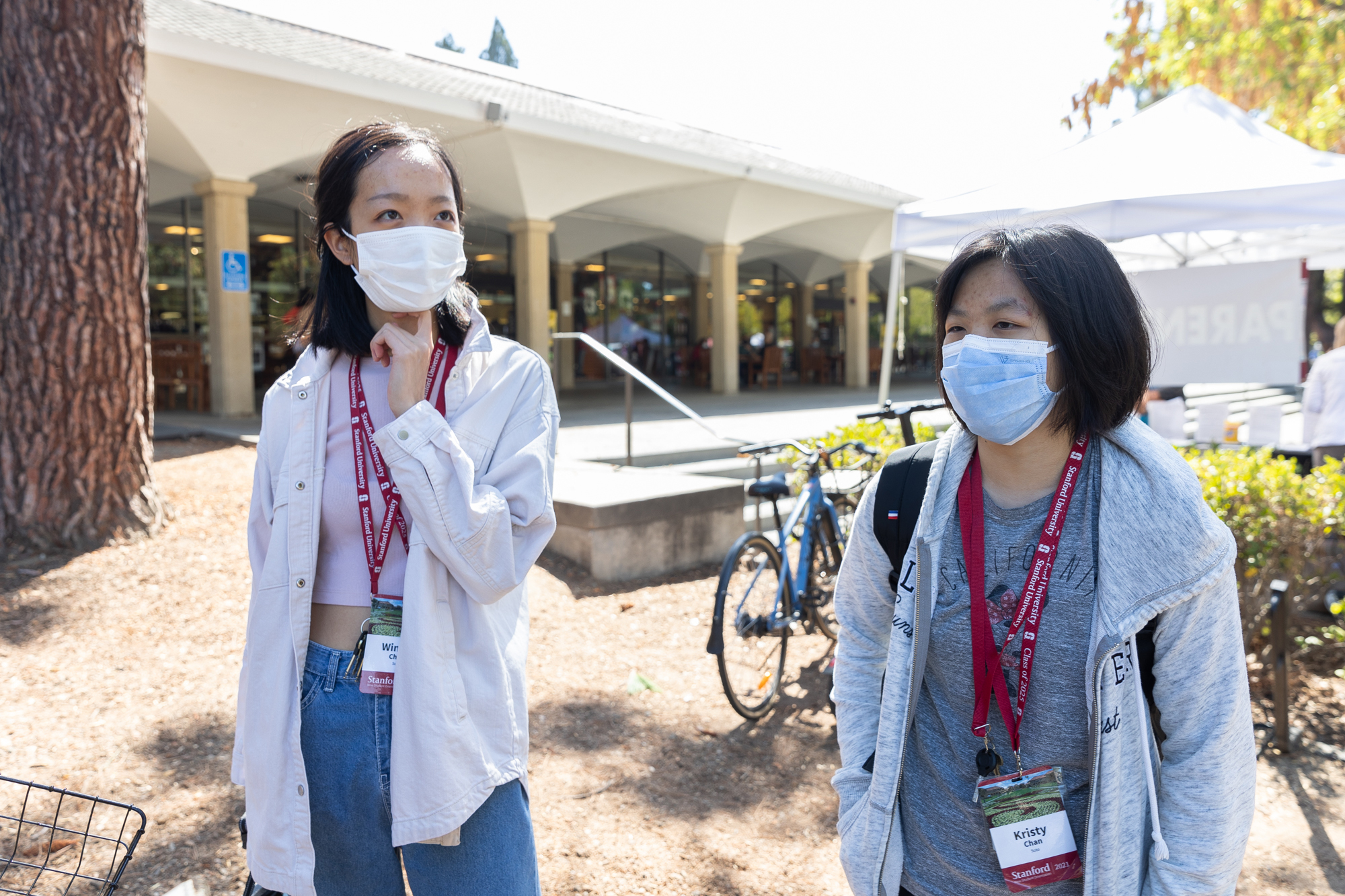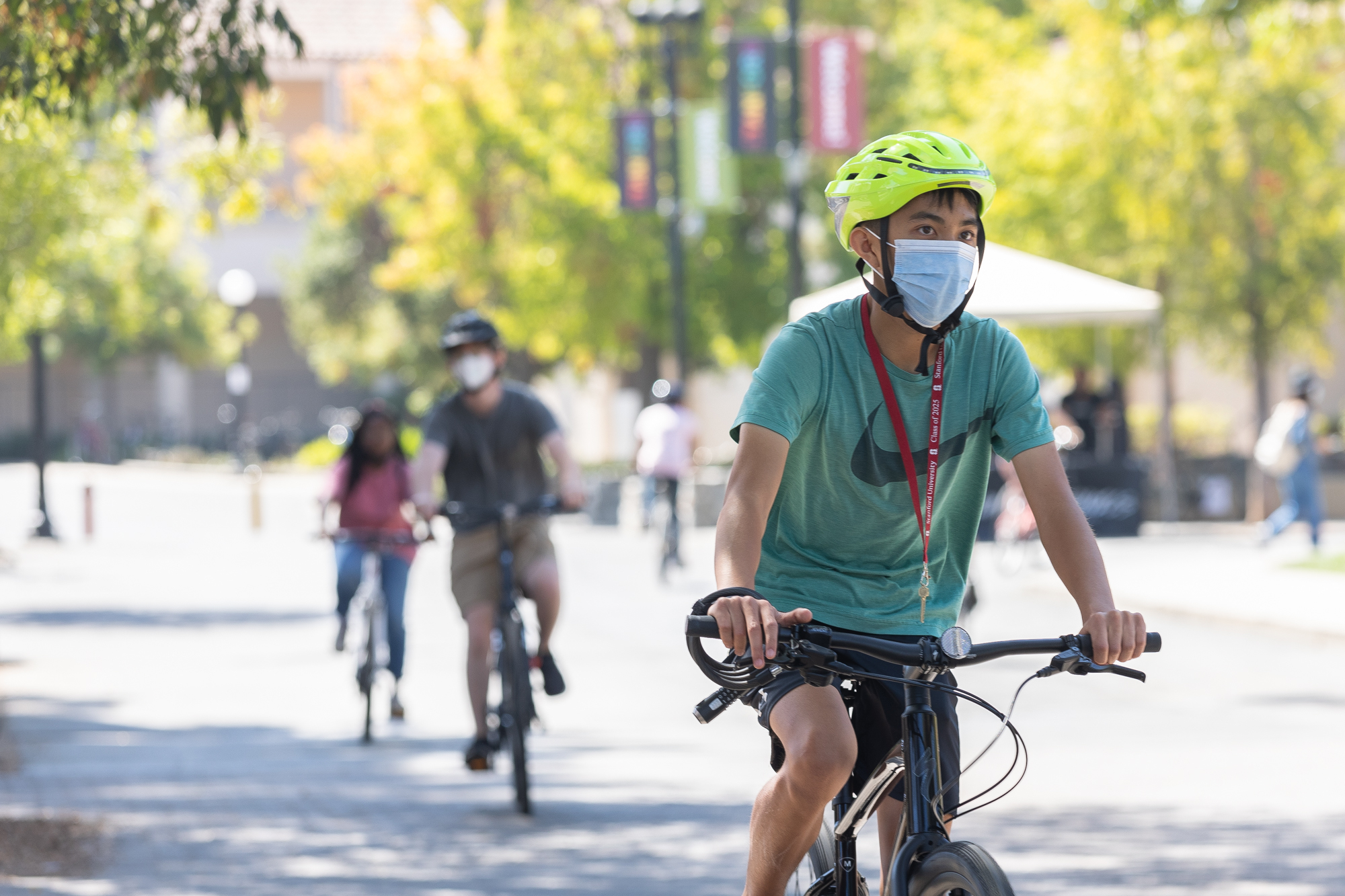When Saga Helgason was admitted to a graduate program at Stanford University last year, she was faced with the prospect of taking classes from her home in Iceland, which would have meant a seven-hour time difference.
Helgason instead decided to try to wait out the pandemic and defer her admission until this fall. She's now on campus, getting ready to start a one-year masters program in Russian, Eastern European and Eurasian Studies.
"Here I am, in the same time zone and getting to meet people — that's part of the whole Stanford experience," Helgason said as she stood outside the campus bookstore last week. "It's not just taking classes, it's also meeting people and being here."
She is one of thousands of Stanford students who have returned to campus for face-to-face classes this fall. Stanford's fall quarter begins today (Sept. 20). This year's incoming undergraduate class is the largest in Stanford's history, with 2,131 first-year students and 66 transfer students, according to the university.
Since March 2020, most of Stanford's classes have been conducted remotely. Instruction is now resuming in person, with only a few classes offered online, university spokesperson E.J. Miranda said in an email. He declined a request for this news organization to interview a university administrator about the reopening.
Stanford requires all students get vaccinated against COVID-19, except those who receive a religious or medical exemption. Any unvaccinated student has to get a COVID-19 test twice per week, while those who are fully vaccinated must still test once a week.
Masks are required indoors, including in classrooms, and are strongly recommended in crowded outdoor settings where 6 feet of distance can't be maintained between people.
Freshman Kwame Ocran was glad to be on campus last week and said he felt good about the vaccine and testing requirements, but added that it can sometimes be uncomfortable navigating how to socialize with other students. "You want to stay safe," Ocran said. "And you can't guarantee that other people are taking the same procedures."
Indoor student parties are officially banned until Oct. 8, although gatherings in individual dorm rooms or apartments are allowed, so long as they don't exceed four times the regular number of occupants.
Classes resume
Throughout the spring, undergraduate classes were mostly remote, Miranda said, with graduate instruction "almost entirely remote." The start of the fall quarter marks the first time since the pandemic hit that face-to-face instruction is the norm.
Some courses will remain fully remote this fall "for pedagogical reasons due to masking requirements," according to the university's website. That includes certain language and music classes. One of Helgason's classes, a language-learning course, is being held online.
"I would much prefer to have it in-person, but because of the mask mandate, it might be easier for us to learn when we can see the professor's face," she said.
Freshman Winnie Chen said she's seen that some bigger lecture classes are being held online, including one of the courses she is taking. Chen and fellow freshman Kristy Chan said they don't know what campus is normally like but are getting used to how things are operating this year.
"Overall, I'm just really excited to see where my college experience takes me," Chen said.
Ocran said he is glad to be able to attend classes in person, especially after experiencing how "inefficient and honestly unmotivating" his online classes were during high school.
Fellow freshman Biak Tha Hlawn was also happy to be able to return to in-person learning, but said she hopes the university has procedures in place to support students in case the campus has to shut down again.
"Hopefully they don't dismiss us unexpectedly," Hlawn said. "That's my biggest worry."
Transmitting COVID-19 is unlikely among masked and vaccinated people, the university has said in messages to students and staff.
"Such an environment — highly vaccinated, with mask wearing in many settings — is what we expect to have at Stanford this fall," Associate Vice Provost of Environmental Health and Safety Russell Furr wrote in a Sept. 2 update.
If anyone who attended an in-person class tests positive for COVID-19, the full class will be notified that there was a positive test, according to the university's protocols.
"Because face coverings are required and vaccination rates are high, students and instructors in a class are not considered high-risk exposure close contacts and will not be asked to take special measures unless they have been identified as a high-risk exposure close contact in an additional setting outside the classroom," according to the university's guidance on courses this fall. "They will be encouraged to continue testing, monitor for symptoms, and stay home if feeling sick and get a COVID-19 test."
Welcoming new students
Undergraduates moved into their dorms earlier this month during prescheduled one-hour move-in appointments, with two guests allowed to enter per student.
According to Ocran, the move-in process went better than he expected. Hlawn similarly said she was pleased with the process.
"Everything was efficient and convenient," Hlawn said. "It was good."
She also praised the university for creating a welcoming environment, particularly pointing to the FLI student orientation, which is for first-generation and low-income students. Hlawn said it was uplifting and made her feel supported.
One hiccup in Stanford's return this fall has been that resident assistants announced they were going on strike earlier this month. The RAs allege that the university didn't meet demands related to compensation, COVID-19 safety protocols and a new undergraduate alcohol policy, according to the student news outlet The Stanford Daily. The RAs object to the requirement that they report underage drinking to the university.
The striking RAs refused to attend training, but helped prepare dorms and welcomed residents to campus, The Stanford Daily reported. Miranda said in an email that "undergraduates are moving into their housing as planned."
At sophomore convocation on Sept. 19, a group of more than 150 sophomores protested the university's new drug and alcohol policy and its response to sexual violence, including raising a banner reading "Stanford Protects Rapists," The Stanford Daily reported. The protesters objected to an original version of the new policy, which they feared would lead students not to report sexual violence for fear of facing disciplinary measures for underage drinking or drug use. The policy has since been updated to address some of the concerns, according to The Stanford Daily.
In a statement, university spokesperson Pat Lopes Harris said that students who report experiencing sexual violence won't face disciplinary action because of alcohol or drug use connected to the incident.
"The prevention of sexual violence is of utmost importance to the university, and nothing in the Alcohol and Other Drugs Policy is intended to chill victims’ willingness to seek help or report such matters," she wrote.
University administrators and student speakers celebrated the incoming class at an opening convocation ceremony on Sept. 14. Stanford President Marc Tessier-Lavigne spoke about rising to meet the challenges we are collectively facing, according to an article about convocation from the university.
"If we take anything from our experiences of the last year and a half, it should be to reengage with the world and with one another with a renewed sense of purpose and with an urgency to make the most of the opportunities in front of us," Tessier-Lavigne said.
The university is also hosting "We are Stanford: A Festival of Reflection and Renewal" Sept. 30 through Oct. 10 to mark the broader campus reopening this fall. The events include concerts, yoga classes and meditation sessions.






Comments